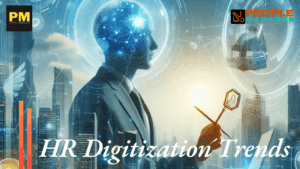HR Analytics: Leveraging Data for Strategic Workforce Planning
Why future-ready leaders treat workforce planning as strategy—not just HRʼs responsibility

Strategic Workforce Planning Through HR Analytics” argues that financial analysis has traditionally been the cornerstone of business strategy, a forward-looking perspective incorporating people is now crucial for sustained success. The effective workforce planning transcends basic HR functions like hiring and firing, and instead acts as a strategic tool that aligns talent with future business objectives through data-driven insights. This requires combining macro-level organizational trends with micro-level individual performance data to make informed decisions, acknowledging that qualitative observations are equally vital alongside quantitative metrics. Ultimately, the piece advocates for using HR analytics to proactively forecast talent needs and challenges, rather than merely reacting to them.
From Balance Sheets to Body Language
For generations, Marwadi businesses have thrived on razor-sharp financial discipline. Every rupee is tracked, reconciled, and optimized. This accounting-led mindset has been a time-tested formula for sustainability and scale.
But today, balance sheets alone donʼt build enduring businesses. What about the people behind the numbers? The ones delivering the revenue, absorbing the pressure, solving problems before they escalate?
The truth is: holistic success requires more than a sprinkle of people-led business management. The smartest leaders arenʼt just financially savvy; theyʼre workforce-aware. They donʼt just know what happened last quarter. Theyʼre already living in the next.
That means looking beyond retrospectives. Living in the future. Building the muscle to anticipate – not just react. And making decisions that are not only preventive, but proactive. And thatʼs where HR analytics comes in. Not as a fancy dashboard, but as a strategic compass. One that helps you read the mood, not just the metrics.
Because today, your people are your business plan.
Reframing Workforce Planning: Beyond Hiring and Firing
Ask most founders or department heads what workforce planning means, and youʼll get a familiar list: hiring the right people, paying them on time, promoting the good ones, and letting go of the rest. Thatʼs not strategy. Thatʼs maintenance.
Workforce planning isnʼt a checklist. Itʼs choreography: the art of aligning people, skills, costs, and capacity with where the business is headed-not just where it is today. If youʼre only thinking about roles that are currently open, youʼre already late. If youʼre only reacting to performance reviews, youʼve already missed the inflection point. The goal isnʼt to manage headcount. Itʼs to design a workforce that moves in sync with your growth vision-quarter by quarter, not crisis by crisis.
Hereʼs where HR analytics changes the game. Instead of building plans based on whatʼs visible today, you start evaluating:
- What capabilities will we need three quarters from now?
- Which teams are likely to hit burnout or stagnation?
- What are the cost implications of hiring externally vs. grooming internally?
These arenʼt guesses. Theyʼre calculated, data-backed decisions. When you widen your view and treat workforce planning as a living strategy, not an annual HR formality.
Marrying Macro + Micro: The Two Views Every Leader Needs
Most business leaders either zoom out too far or zoom in too close. The macro thinkers focus on department-level data-attendance patterns, budget overruns, team productivity reports. The micro-managers obsess over individual KPIs, whoʼs performing, whoʼs slacking, and whoʼs likely to leave.
But great workforce strategy simultaneously needs both lenses.
Letʼs say your marketing team is running over budget. A macro view might show low campaign ROI or increasing attrition. But the micro view could reveal that your top performer has been working late nights, taking on extra load after two resignations. If you only look at one, youʼll solve the wrong problem.
Macro metrics include things like:
- Team attendance and time-tracking anomalies
- Vertical-wise ROI (revenue per employee, cost per hire)
- Frequency of complaints or internal conflicts
Micro insights zoom in on:
- Which interviewer consistently closes positions faster
- Which employee shows early signs of disengagement
- Which managerʼs team has high output and high retention
The power lies in layering both.
Numbers give you signals. Stories give you direction.
And when the two disagree – as they sometimes will, remember Jeff Bezosʼ advice: “When the data and the anecdotes disagree, the anecdotes are usually right.ˮ
In practice, that means donʼt override your intuition with numbers. But also donʼt make gut decisions without numbers to test them.
Use macro to diagnose. Use micro to intervene. And let both shape your workforce decisions before they become workforce problems.
Lazy Leadership Relies on Numbers Alone
In most businesses, thereʼs no shortage of data. Attendance sheets. Performance scores. Appraisal cycles. Exit forms. But hereʼs the uncomfortable truth: Relying only on quantitative data is leadership on autopilot.
Itʼs easy to read charts. Itʼs harder to read between the lines.
- A sales team might hit its revenue target. But is it burning out in the process?
- An employee might be rated “averageˮ for two years. But has anyone explored why that plateau exists?
- A department might show low attrition-but is that a sign of stability… or suppressed ambition?
This is where most managers stop. Great managers dig. They ask:
- Whatʼs the emotional temperature of the team?
- Are people growing, or just grinding?
- Is that exit interview an outlier, or the beginning of a trend?
Thatʼs where qualitative data enters.
Mood during meetings. Energy in daily standups. Honest feedback in anonymous surveys. Even hallway conversations. This kind of data doesnʼt show up on a dashboard. But it shows up in results. Every time.
When you combine quantitative reports with qualitative reality, you stop managing from the rearview mirror. You start making calls that are sharper, fairer, and more human.
Because the truth is: data should inform your instincts-not replace them.
Three Must-Use Applications of HR Analytics
The true value of HR analytics isnʼt in pretty dashboards. Itʼs in the decisions you make before things go wrong and the direction you give to move things right. Here are three powerful, practical ways to use HR analytics for strategic workforce planning.
1. Sentiment Analysis
Your team may not always say how they feel. But how they respond to internal surveys, emails, reviews, and manager interactions can reveal plenty. Use sentiment analysis tools to track tone, emotional shifts, and engagement dips across departments.
Why it matters:
By the time someone quits, their motivation has likely been falling for months. Sentiment data gives you early warning signals so you can intervene early with coaching, check-ins, or realignment.
2. Attrition Forecasting
Resignations shouldnʼt be treated as random events. Theyʼre patterns waiting to be decoded. Track variables like role tenure, promotion timelines, manager transitions, work-life balance scores, and even commute times. Layer them with behavioral signals: like reduced 11 participation or a drop in project ownership.
Why it matters:
Forecasting attrition helps you create proactive retention plans, secure replacements in time, and avoid institutional knowledge loss.
3. Skill Gap Mapping
Workforce planning is useless if you donʼt know what skills your future needs require and whether your current team has them. Compare upcoming business goals and technologies with internal skill inventories, training history, and performance outcomes.
Are you training your team on prompt engineering when AI agents may be the future? Also assess learning velocity – who picks up new capabilities quickly? Who resists change?
Why it matters:
Skill gap data helps you choose between hiring and upskilling. It turns vague ‘training budgetsʼ into precise capability investments.
These arenʼt vanity metrics. Theyʼre decision tools-for leaders who want to stay ahead, not just stay informed.
Live in the Future: Forecast. Donʼt Firefight.
- Most businesses spend their time putting out fires.
- Someoneʼs leaving – scramble to hire.
- Performance is dipping-schedule a review.
- Team morale is low-send out a survey.
Itʼs reactive. Itʼs inefficient. And itʼs expensive.
The rea
l value of HR analytics lies in its ability to shift you from reactive firefighting to proactive forecasting. What if you could:
- Spot burnout before it hits your high performers?
- See a departmentʼs rising workload and plan reinforcements a quarter in advance?
- Predict attrition patterns and redesign roles before people resign?
Thatʼs not wishful thinking-itʼs strategic readiness. It starts with creating forecast models. Models that align hiring needs with revenue projections. That assess capability risks for upcoming projects. That guide your training calendar-not based on generic modules, but on actual team needs.
It also means budgeting smarter.
- Not just for headcount, but for impact per head.
- Not just for annual increments, but for long-term internal mobility.
This is what living in the future looks like. Youʼre not reacting to problems. Youʼre creating conditions where fewer problems arise in the first place. Because if your people are your biggest asset, anticipation isnʼt a luxury-itʼs your responsibility.
In Conclusion: The CFO Mindset Must Meet CHRO Wisdom
For decades, business success has been measured through cost control, revenue growth, and margin management. Itʼs why many entrepreneurs-especially those from traditional business families-have a deep respect for the numbers. Itʼs clear, measurable, and tangible.
But in todayʼs world, you canʼt spreadsheet your way to greatness. The smartest leaders today arenʼt just fluent in financial models. Theyʼre fluent in people dynamics, capability mapping, behavioral patterns, and culture signals.
Thatʼs what HR analytics enables. It allows you to bring the same precision you apply to your profit margins to your teams. It gives you frameworks to back your instinct-and data to sharpen your judgment. It helps you see who is growing, who is coasting, and who is quietly slipping away before the resignation lands on your desk.
But hereʼs the catch: tools wonʼt solve this alone. Just like financial data is meaningless without interpretation, HR data is powerful only in the hands of leaders who care to look deeper. Leaders who take action. Leaders who listen not just to whatʼs said but whatʼs felt.
This is where the next wave of business excellence will be born-not just in better execution, but in better anticipation.
So, if youʼre still treating workforce planning as an HR function, youʼre missing the plot. Itʼs a strategic imperative. And if youʼre only using analytics to see what happened last month, youʼre already behind.
Look forward. Lead forward.
Because the companies that win tomorrow are the ones building future-ready teams today. For further insights into the evolving workplace paradigm, visit






